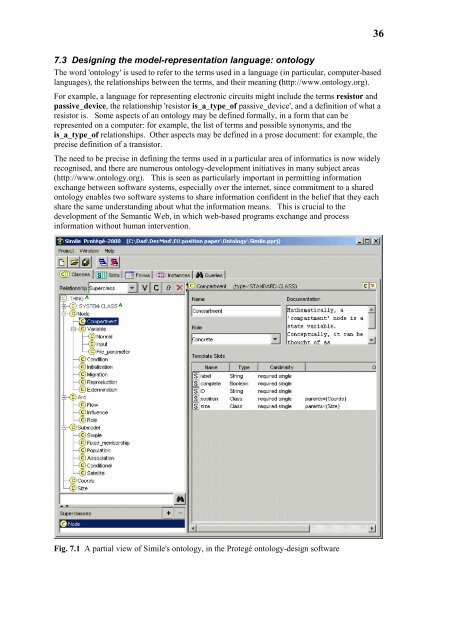pdf: 600KB - Potsdam Institute for Climate Impact Research
pdf: 600KB - Potsdam Institute for Climate Impact Research
pdf: 600KB - Potsdam Institute for Climate Impact Research
You also want an ePaper? Increase the reach of your titles
YUMPU automatically turns print PDFs into web optimized ePapers that Google loves.
36<br />
7.3 Designing the model-representation language: ontology<br />
The word 'ontology' is used to refer to the terms used in a language (in particular, computer-based<br />
languages), the relationships between the terms, and their meaning (http://www.ontology.org).<br />
For example, a language <strong>for</strong> representing electronic circuits might include the terms resistor and<br />
passive_device, the relationship 'resistor is_a_type_of passive_device', and a definition of what a<br />
resistor is. Some aspects of an ontology may be defined <strong>for</strong>mally, in a <strong>for</strong>m that can be<br />
represented on a computer: <strong>for</strong> example, the list of terms and possible synonyms, and the<br />
is_a_type_of relationships. Other aspects may be defined in a prose document: <strong>for</strong> example, the<br />
precise definition of a transistor.<br />
The need to be precise in defining the terms used in a particular area of in<strong>for</strong>matics is now widely<br />
recognised, and there are numerous ontology-development initiatives in many subject areas<br />
(http://www.ontology.org). This is seen as particularly important in permitting in<strong>for</strong>mation<br />
exchange between software systems, especially over the internet, since commitment to a shared<br />
ontology enables two software systems to share in<strong>for</strong>mation confident in the belief that they each<br />
share the same understanding about what the in<strong>for</strong>mation means. This is crucial to the<br />
development of the Semantic Web, in which web-based programs exchange and process<br />
in<strong>for</strong>mation without human intervention.<br />
Fig. 7.1 A partial view of Simile's ontology, in the Protegé ontology-design software
















